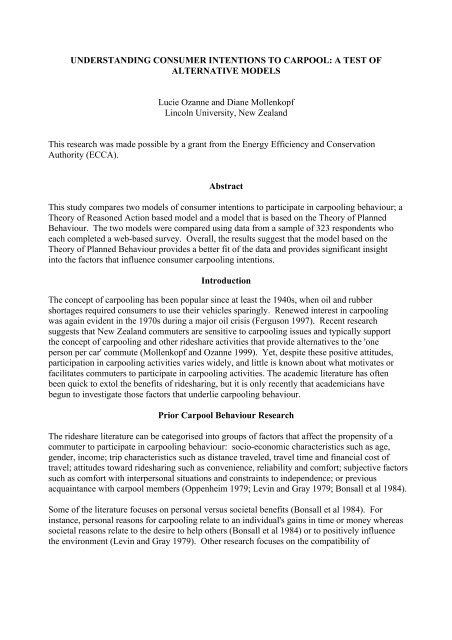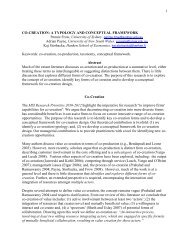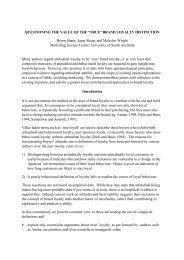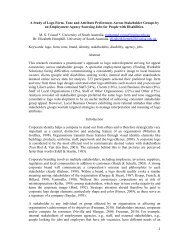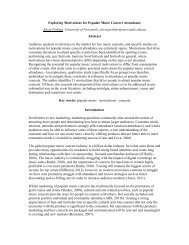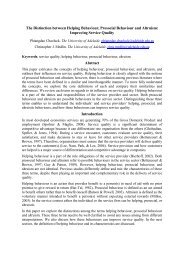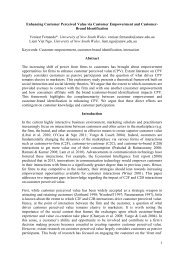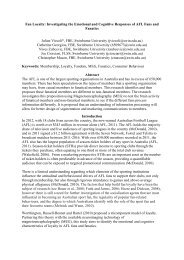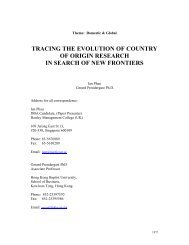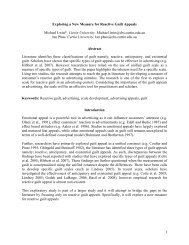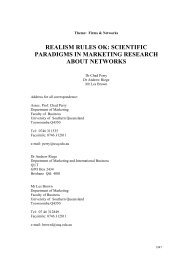UNDERSTANDING CONSUMER INTENTIONS TO ... - ANZMAC
UNDERSTANDING CONSUMER INTENTIONS TO ... - ANZMAC
UNDERSTANDING CONSUMER INTENTIONS TO ... - ANZMAC
Create successful ePaper yourself
Turn your PDF publications into a flip-book with our unique Google optimized e-Paper software.
<strong>UNDERSTANDING</strong> <strong>CONSUMER</strong> <strong>INTENTIONS</strong> <strong>TO</strong> CARPOOL: A TEST OF<br />
ALTERNATIVE MODELS<br />
Lucie Ozanne and Diane Mollenkopf<br />
Lincoln University, New Zealand<br />
This research was made possible by a grant from the Energy Efficiency and Conservation<br />
Authority (ECCA).<br />
Abstract<br />
This study compares two models of consumer intentions to participate in carpooling behaviour; a<br />
Theory of Reasoned Action based model and a model that is based on the Theory of Planned<br />
Behaviour. The two models were compared using data from a sample of 323 respondents who<br />
each completed a web-based survey. Overall, the results suggest that the model based on the<br />
Theory of Planned Behaviour provides a better fit of the data and provides significant insight<br />
into the factors that influence consumer carpooling intentions.<br />
Introduction<br />
The concept of carpooling has been popular since at least the 1940s, when oil and rubber<br />
shortages required consumers to use their vehicles sparingly. Renewed interest in carpooling<br />
was again evident in the 1970s during a major oil crisis (Ferguson 1997). Recent research<br />
suggests that New Zealand commuters are sensitive to carpooling issues and typically support<br />
the concept of carpooling and other rideshare activities that provide alternatives to the 'one<br />
person per car' commute (Mollenkopf and Ozanne 1999). Yet, despite these positive attitudes,<br />
participation in carpooling activities varies widely, and little is known about what motivates or<br />
facilitates commuters to participate in carpooling activities. The academic literature has often<br />
been quick to extol the benefits of ridesharing, but it is only recently that academicians have<br />
begun to investigate those factors that underlie carpooling behaviour.<br />
Prior Carpool Behaviour Research<br />
The rideshare literature can be categorised into groups of factors that affect the propensity of a<br />
commuter to participate in carpooling behaviour: socio-economic characteristics such as age,<br />
gender, income; trip characteristics such as distance traveled, travel time and financial cost of<br />
travel; attitudes toward ridesharing such as convenience, reliability and comfort; subjective factors<br />
such as comfort with interpersonal situations and constraints to independence; or previous<br />
acquaintance with carpool members (Oppenheim 1979; Levin and Gray 1979; Bonsall et al 1984).<br />
Some of the literature focuses on personal versus societal benefits (Bonsall et al 1984). For<br />
instance, personal reasons for carpooling relate to an individual's gains in time or money whereas<br />
societal reasons relate to the desire to help others (Bonsall et al 1984) or to positively influence<br />
the environment (Levin and Gray 1979). Other research focuses on the compatibility of
carpooling with a commuter's life and work, particularly in the commuter/employer relationship.<br />
Company size, assistance in finding carpool partners, worktime flexibility and work schedules<br />
have all been associated with a commuter's propensity to carpool (Cervero and Griesenbeck<br />
1988; Ferguson 1990).<br />
The rideshare literature has been rich and varied in its approach to understanding commuting<br />
behaviour; only a few of the major publications have been discussed here. A major gap in the<br />
carpool literature, however, has been the lack of any systematic approach or underpinning theory<br />
to the research. The wider environmental literature is beginning to develop a theoretical<br />
framework, particularly based on the Theory of Reasoned Action (Fishbein and Ajzen 1975) and<br />
the Theory of Planned Behaviour (Ajzen 1985, 1991). These theoretical approaches are applied<br />
to carpooling in this study in order to better understand the motivations and barriers to<br />
carpooling behaviour.<br />
Applying Marketing Theory to Carpool Behaviour<br />
The Theory of Reasoned Action (TRA) is a theory of attitude-behaviour relationships which<br />
links attitudes, subjective norms, behavioural intentions and behaviour in a fixed causal sequence<br />
(Sparks and Shepperd 1992). Behaviour is asserted to result from behavioural intention, which<br />
in turn is asserted to arise out of a combination of people's attitudes towards performing the<br />
behaviour of interest and their perceptions of the social expectations (norms) put upon them to<br />
perform that behaviour. Attitudes are suggested to arise from a combination of people's beliefs<br />
about behavioural outcomes and their evaluations of those outcomes. Subjective norms are<br />
similarly proposed as arising from a combination of people's perceptions that important others<br />
think they should, or should not, perform the behaviour of interest and their motivation to<br />
comply with the wishes of others (See Figure 1).<br />
Behavioural Beliefs &<br />
Outcome Evaluations<br />
Attitude<br />
Behavioural<br />
Intention<br />
Behaviour<br />
Normative Beliefs &<br />
Motivation to Comply<br />
Subjective<br />
Norms<br />
Figure 1: Model of the Theory of Reasoned Action<br />
The TRA is an appropriate model when behaviour is under an individual's volitional control (i.e.,<br />
if the individual can decide at will to perform or not perform the behaviour). However, the<br />
theory fails to take account of factors that facilitate or inhibit performance of behaviours over<br />
which people have only partial control. The Theory of Planned Behaviour (TPB) extends the<br />
TRA by adding perceived behavioural control as a determinant of behaviour and behavioural<br />
intention, by incorporating a construct that deals with people's perception of control over the<br />
behaviour. That is, their beliefs that they can perform the behaviour if they so desire, that they
have the required time, skills, resources and cooperation of others are expected to be positively<br />
associated with behavioural intentions, and actual behaviour (See Figure 2).<br />
The Present Study<br />
The work by Taylor and Todd (1995, 1997) on composting and garbage reduction behaviour<br />
serves as a foundation for the hypothesised models explaining carpooling behaviour. However,<br />
we have adapted their models as a consequence of a pilot study to elicit salient beliefs related to<br />
carpooling. In our two models, attitude is hypothesised to be positively related to behavioural<br />
intentions. Similar to Taylor and Todd (1997) we hypothesise that both personal and societal<br />
advantages will be positively associated with attitude. However, compatibility beliefs are<br />
believed to be related to attitude rather than perceived behavioural control. This change is also<br />
suggested by the literature on innovation adoption, which suggests that the key determinants of<br />
adoption are relative advantage, compatibility and complexity (Rogers 1983).<br />
Behavioural Beliefs &<br />
Outcome Evaluations<br />
Attitude<br />
Normative Beliefs &<br />
Motivation to Comply<br />
Subjective<br />
Norms<br />
Behavioural<br />
Intention<br />
Behaviour<br />
Control Beliefs &<br />
Perceived Facilitation<br />
Perceived<br />
Behavioural<br />
Control<br />
Figure 2. Model of the Theory of Planned Behaviour<br />
Both internal and external normative beliefs about carpooling are hypothesised to be positively<br />
related to subjective norms. In the TPB model, perceived behavioural control is hypothesised to<br />
be composed of beliefs about resource facilitating conditions and beliefs about the ability to<br />
carry out the behaviour, or self-efficacy. Although not part of the TRA or TPB, previous research<br />
has suggested the importance of past behaviour in predicting current or future behaviour<br />
(Norman and Conner 1996; Van Ryn et al. 1996; Reinecke et al. 1996). Therefore, past<br />
experience with carpooling is hypothesised to have a direct relationship on future carpooling<br />
intentions, as well as an indirect relationship on behavioural intentions via attitudes. For this<br />
study an actual measure of carpooling behaviour was not feasible. Thus, this research focuses<br />
upon the relationship between behavioural intentions and the independent variables. See Figures<br />
3 and 4 for the TRA and TPB based models.
The study was conducted in a field setting using survey methodology. A web-based<br />
questionnaire was used to collect data. Development of the scales to measure each of the<br />
constructs in the model proceeded through a series of steps, based on the procedures suggested<br />
by Ajzen and Fishbein (1980) and Ajzen (1985, 1991). The questionnaire was then subjected to<br />
two rounds of pretesting on the web prior to sending out the final instrument.<br />
Results<br />
A total of 956 e-mail letters were sent to staff at a New Zealand university and local research<br />
organisations. From this sample pool, 323 useable responses were received, for an effective<br />
response rate of 34%. Before commencing analysis of the theoretical models, all variables were<br />
examined for reliability, validity and normality, and were deemed adequate for further analysis.<br />
Each of the two models presented above was then subjected to path analysis testing, using<br />
AMOS 3.6 software for structural equation modeling. A path analysis approach was used<br />
because all variables were manifest rather than latent. Introducing latent variables in addition to<br />
the manifest variables would have required a larger sample size.<br />
The data did not prove to be a good fit for the proposed TRA model. The best model, achieved<br />
had a Chi square of 160.12, 11df. Although 41% of the variance in carpool behavioural intention<br />
was explained in the model, the root mean square error of .21, p=.00 indicated the poor fit of the<br />
model to the data.<br />
Carpooling intentions were better explained when the data were tested using the TPB model.<br />
However, the model did not fit exactly as hypothesised. The best fitting model, presented in Figure<br />
3, achieved a Chi square of 14.95, 5df, with a rmsea of .08, p=.13.<br />
SRA<br />
PRA<br />
COMPAT<br />
EXPER<br />
INT_NORM<br />
.18<br />
.23<br />
.30<br />
.22<br />
0, 1<br />
err1<br />
.78<br />
.40<br />
ATTITUDE<br />
.13<br />
.20<br />
SUBNORM<br />
.37<br />
0, 1<br />
Err4<br />
.70<br />
.50<br />
INTENT<br />
Hypothesised<br />
relationship (not<br />
significant)<br />
Hypothesised<br />
relationship<br />
(significant at p ≤ .05)<br />
Significant<br />
relationship (p ≤ .05),<br />
not hypothesised<br />
Significant covariance<br />
relationship (p ≤ .05)<br />
EXT_NORM<br />
FAC_RES<br />
SELF_EFF<br />
.40<br />
.19<br />
Err2<br />
0, 1<br />
PB_CONT<br />
.87 0, 1<br />
Err3<br />
.25<br />
.29<br />
Chi square = 14.95<br />
df = 5 p = .01<br />
cmindf = 2.99<br />
rmsea = .08<br />
p of close fit = .13<br />
Figure 3. Carpooling Behaviour as Explained by the Theory of Planned Behaviour
Discussion and Conclusion<br />
The intent of this study was to compare two models of consumer intentions to participate in<br />
carpooling behaviour, based on the TRA and the TPB. Both models are based on a theoretical<br />
foundation but also incorporate many of the factors that have been found to be related to many<br />
environmental behaviours.<br />
Although the TRA model has been useful in a number of other settings (Sheppard et al 1988), this<br />
model does not do an adequate job of explaining carpooling behaviour. This finding supports the<br />
results of other studies that have used the TRA to understand environmental behaviours (Bagozzi<br />
and Dabholkar 1994; Goldenhar and Connell 1993; Taylor and Todd 1997). This suggests that<br />
carpooling behaviour is not purely volitional and other factors, such as perceived behavioural<br />
control, need to be incorporated to augment the TRA model.<br />
The TPB does provide a stronger basis for exploring the relationships and predicting carpooling<br />
behaviour. First, Attitude is the key determinant of Behavioural Intentions, suggested by the strong<br />
statistical link between ATTITUDE and INTENT. Thus, the more convenient, flexible and pleasant<br />
a respondent finds carpooling, the more likely s/he is to engage in carpooling behaviour. In turn,<br />
Attitude towards carpooling is positively influenced by Personal Relative Advantages, as predicted.<br />
That is, the more a respondent felt that s/he could save money, reduce wear and tear on the car, find<br />
a carpark more easily, or interact with others, the more favourable his/her attitude towards<br />
carpooling. Compatibility is also positively related to Attitude, as expected. This means that to the<br />
extent that carpooling does not compromise a respondent’s flexibility, independence, work<br />
hours/schedule, or other commitments, the more favourable his/her attitude towards carpooling.<br />
Additionally, Compatibility is also directly related to Behavioural Intention, as indicated by the<br />
significant link between COMPAT and INTENT. This had not been hypothesised from theory and<br />
is an important finding in understanding carpool behaviour because of the direct effect that<br />
incompatibility may have on one’s carpool intentions.<br />
Attitude is also positively influenced by having previous carpool experience, as predicted. This<br />
relationship had not been suggested in the TPB, but has been suggested in previous research.<br />
Thus, the addition of this variable to the theoretical model has helped provide additional<br />
explanatory power to the model.<br />
Surprisingly, Facilitating Resources were also found to be positively related to Attitude, as this<br />
had not been foreseen in the theoretical model based on the TPB. However, it does make<br />
intuitive sense that to the extent someone has the resources to engage in carpooling (eg, having<br />
access to others who want to carpool, an ‘arrangeable’ work schedule, and time to plan for<br />
carpooling arrangements), the more positive one would feel about carpooling. Thus, the<br />
relationship between Facilitating Resources and Attitude is an important finding.<br />
Second, Subjective Norm (as measured directly, or through internal and external influences) is<br />
not related to carpooling intentions . This finding is contrary to the Theory of Planned<br />
Behaviour, but is an important finding in carpool research in New Zealand.<br />
Third, Perceived Behavioural Control is directly related to Behavioural Intentions, as predicted.<br />
This means that non-motivational factors such as the amount of control one perceives over
commuting options, one’s perceived ability to undertake carpooling, or the perceived ease of<br />
carpooling, are positively related to carpooling intentions. This is supported by the positive<br />
relationship between Perceived Behavioural Control and Facilitating Resources, and suggests the<br />
importance of resources to one’s sense of control over a situation.<br />
Fourth, previous experience was also found to be directly related to Perceived Behavioural<br />
Control. While this relationship had not been predicted, it makes sense that having had previous<br />
experience would increase one’s sense of control in carpooling situations. Experience was also<br />
found to be directly related to Behavioural Intention, as predicted. The importance of<br />
Experience in influencing Attitude, Perceived Behavioural Control and Behavioural Intention are<br />
all important findings, and have implications for promotion and policy actions.<br />
Although the intent of this study was to compare two models of consumer intentions to<br />
participate in carpooling, the findings also provide insight for increasing carpooling behaviour.<br />
In the carpooling setting, the intention to carpool is determined by one's attitudes toward<br />
carpooling, perceived control over carpooling behaviour, and previous experience. Thus,<br />
policymakers should concentrate on tools to influence attitudes and perceived behavioural<br />
control. Further policy insights can be found in Mollenkopf and Ozanne (1999).<br />
References<br />
Ajzen, Icek and Martin Fishbein (1980), Understanding Attitudes and Predicting Social<br />
Behavior, Prentice-Hall, Englewood Cliffs, NJ.<br />
Ajzen, Icek (1985), “From Intentions to Actions: A Theory of Planned Behavior,” in Action<br />
Control: From Cognition to Behaviour, editors Julius Kuhl and Jurgen Beckmann, Springer-<br />
Verlag, Berlin, 11-39.<br />
---- (1991), “The Theory of Planned Behavior,” Organizational Behavior and Human Decision<br />
Processes, 50, 179-211.<br />
Bagozzi, Richard and P. Dabholkar (1994), “Consumer Recycling Goals and their Effect on<br />
Decisions to Recycle: A Means-end Chain Analysis,” Psychology and Marketing, 11:313-340.<br />
Bonsall, P. W., Spencer, A. H., & Tang, W-S. (1984), "What Makes a Car-sharer?"<br />
Transportation, 12, 117-145.<br />
Cervero, R., & Griesenbeck, B. (1988), "Factors Influencing Commuting Choices in Suburban<br />
Labor Markets: A case Analysis of Pleasanton, California," Transportation Research, 22, 151-<br />
161.<br />
Ferguson, E. (1990), "The Influence of Employer Ridesharing Programs on Employee Mode<br />
Choice," Transportation, 17, 179-207.
---- (1997), "The Rise and Fall of the American Carpool: 1970-1990," Transportation, 24, 349-<br />
376.<br />
Fishbein, Martin and Icek Ajzen (1975), Belief, Attitude, Intention and Behavior: An<br />
Introduction to Theory and Research, Addison-Wesley, Reading, MA.<br />
Goldenhar, L and C. Connell (1993), “Understanding and Predicting Recycling Behavior: An<br />
Application of the Theory of Reasoned Action,” Journal of Environmental Systems, 22, 91-103.<br />
Levin, I. P., & Gray, M. J. (1979), "Evaluation of Interpersonal Influences in the Formation and<br />
Promotion of Carpools," Transportation Research Record, 724, 35-39.<br />
Mollenkopf, Diane and Lucie Ozanne (1999). The Lincoln Connection: Understanding Carpool<br />
Behaviour, report prepared for the Energy Efficiency and Conservation Authority, April.<br />
Norman, Paul and Mark Conner (1996), “Predicting Health-Check Attendance among Prior<br />
Attenders and Nonattenders: The Role of Prior Behavior in the Theory of Planned Behavior,”<br />
Journal of Applied Social Psychology, 26(11),1010-1026.<br />
Oppenheim, N. (1979), "Carpooling: Problems and Potentials," Traffic Quarterly, 33, 253-262.<br />
Reinecke, Jost, Peter Schmidt and Icek Ajzen (1996), “Application of the Theory of Planned<br />
Behavior to Adolescents’ Condom Use: A Panel Study,” Journal of Applied Social Psychology,<br />
26(9),749-772.<br />
Rogers, Everett (1983), Diffusion of Innovations, 3 rd edition, Free Press, New York, NY.<br />
Sparks, Paul and Richard Shepherd (1992), “Self-identity and the Theory of Planned Behavior:<br />
Assessing the Role of Identification with “Green Consumerism”,” Social Psychology Quarterly,<br />
55(4), 388-399.<br />
Sheppard, B., Hartwick, J. and Warshaw, P. (1988). "The Theory of Reasoned Action: A Meta<br />
Analysis of Past research with Recommendations for Modifications and Future Research,"<br />
Journal of Consumer Research, 15, 325-343.<br />
Taylor, Shirley and Peter Todd (1995), “Understanding Household Garbage Reduction Behavior:<br />
A Test of an Integrated Model,” Journal of Public Policy & Marketing, 14(2), 192-204.<br />
---- and ---- (1997), “Understanding the Determinants of Consumer Composting Behaviour,”<br />
Journal of Applied Social Psychology, 27(7), 602-628.<br />
Van Ryn, Michelle, Leslie Lytle and John Kirscht (1996), “A Test of the Theory of Planned<br />
Behavior for Two Health-related Practices,” Journal of Applied Social Psychology, 26(10), 871-<br />
883.


